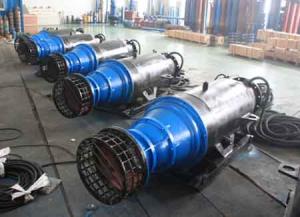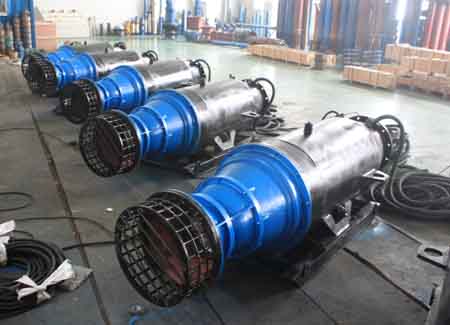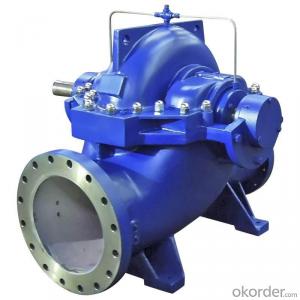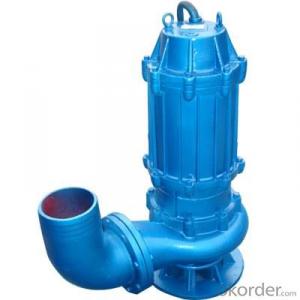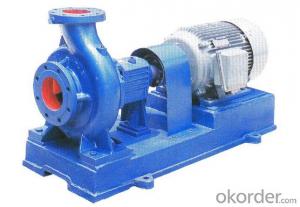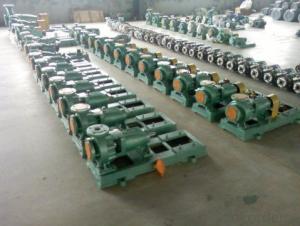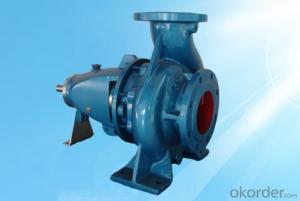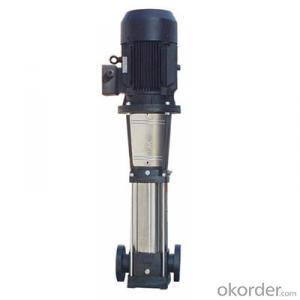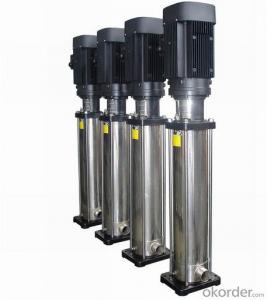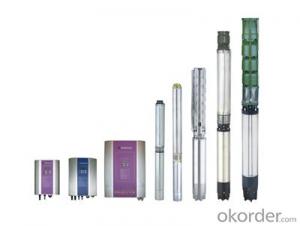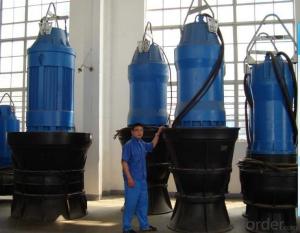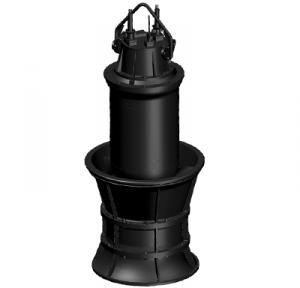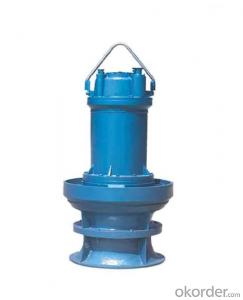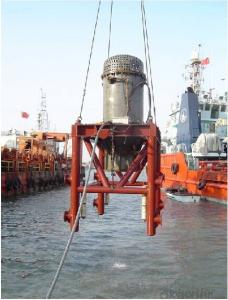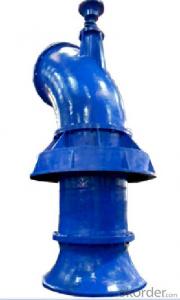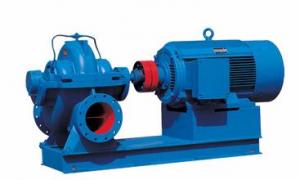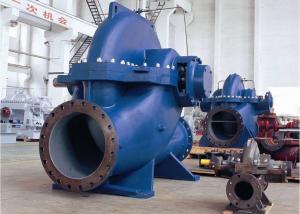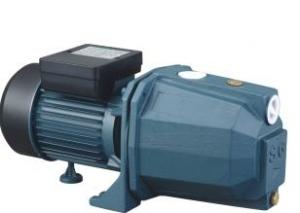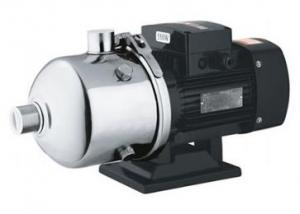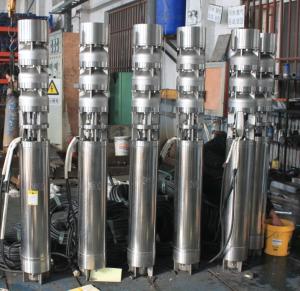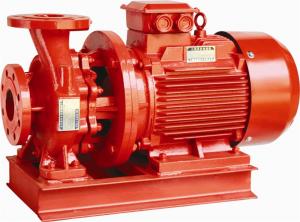Submersible Axial Flow Pump
- Loading Port:
- Tianjin
- Payment Terms:
- TT or LC
- Min Order Qty:
- -
- Supply Capability:
- 99 units unit/month
OKorder Service Pledge
OKorder Financial Service
You Might Also Like
Type description
Take 350QZB-50 as an example
350: the nominal diameter of the pump
Q: submersible
Z: axial flow
B: semi-adjustable blade
50: 1/10 of the pump specific speed (take the integer part)
According to different pump specific speeds, the flow capacity range of this type of axial flow pump can reach up to 700m3-1400 m3
The principle of Axial flow pump is to lifting water according to the thrust caused by the impeller when rotating. Because water moves along the axial in the impeller, so we called it axial flow pump.
In accordance with its mode of installation, axial flow pump can be distinguished into three class: vertical, horizontal, inclined. Their structures are almost the same. Now the vertical form is used widely. The main accessories contains bell-mouthed pipe, impeller, guide blade, outlet syphon, shaft and bearing, stuffing box, etc.
Summarize of QZ series Axial flow pump:
Installation of water flow Channel: in terms of recommended sample installation diagram
The form of water exit: flap valve or other ways
Installation ways: suspended by bent pipe; suspended in well casing, etc.
Motor
Submersible motor
Power Level: electrical performance conforms to GB756
Protection level: IP68
Cooling method: ICW08A41
Basic installation form: IM3013
Voltage grade: ≤355kw, voltage,380v/660v; 355kw,voltage, 380v, 660v, 6000v, 10000v
Insulation level: F
Rated frequency: 50Hz
Length of cable: 10m
Shaft seal
There are two or three stages of mechanical seal. The first stage called carborundum (directly contact with water). The second and third stage called graphite and carborundum.
Leak proof Equipment
QZ, QH series pump have been equipped with leak proof sensors. When the oil tank, the inner part of motor or the junction box has been leaked by water, the sensor will signal or made the motor shut down, and retain the malfunction signal.
Over heating protection system
A overheating protection device is fastened on the motor winding. When the temperature exceeds the stated &#118alue, the device will signal or made the motor shut down.
Rotation direction:
Seen from the top of the motor, the impeller is rotating clock wisely.
Application
QZ series axial flow pump, QH series mixed-flow pump is widely used in industry and agriculture water lifting, urban water supply, light polluted water discharge and other water transfer project.
Working condition
Clean water with the temperature no more than 50 or some liquids that are similar to water.
- Q: 2 different pulleys are in the way of the 2 remaining long bolts. at each end of the pump. tensioner did not need to be moved as belt is already off. Motor mount is 1/2 way removed and motor has dropped slightly gt; Am reading a jack must be placed under motor with wood via oil pan ( am hoping no other damage was done) Am told there is a certain device available to remove the pulleys? ... -Would appreciate anyone's info and advice on the remaining steps to this procedure on this make and model engine. as I have come into it obviously with it having begun the wrong way!! Thanks!!
- to get the water pump out you need to remove the water pump pulley first it has four 10 mm bolts (I have seem them with 8 mm bolt with a large shoulder on them too ) you can break the bolts loose one of 2 ways 1) put a long screwdriver between the two of the bolt to hold the pulley in place while u break one loose then spin the pulley around rinse and repeat once there all loose u can turn them out by hand and pull off the pulley some time u have to give the pully a little tap to come off you shouldn't need to take off the motor mount unless u plan on chaging the serpintine belt ? be sure once you get the pump off you clean the block side of the surface really good with a scraper make sure u get all the old gasket off the block side so it will seal right when u install the new pump I also recommend a tube of ultra black rtv sealant and only black I have used blue silicone before on many occasion and it has failed me I only use black rtv plus it makes it a lot easier if you have to replace the pump in the future as it come off a little easyier hope this helps a little good luck may the car gods be with you also I would recommend doing a back flush with warm or hot water and using the old school green antifreeze either full or 50/50 mix Dexcool orange has a very well know issue of eating gaskets and putting engine into a vapor lock very costly to fix
- Q: I live in a house that uses a pump to push water from a tank to the bathroom and kitchen. It has a sensor that detects if water is flowing and pushes it much harder. Recently, it has been pushing the water for a second or less then it completely stops for a while. It's like a pulse of water then nothing. Can anyone give me feedback on what is wrong here? Thank you.
- from okorder :Self-priming pump working principle is: the pump before you start in the pump shell filled with water (or) from the water in the pump housing.Start after high-speed rotating impeller flow to the vortex in the impeller, shell, then the entry form the vacuum, the inlet non-return door open, within the air into the pump suction tube and the impeller, to arrive at the outer edge.Self-priming pump is a self-priming centrifugal pump, it has compact structure, convenient operation, stable operation, easy maintenance, high efficiency, long service life, and have strong self-priming capacity, etc.Line does not need to install the bottom valve, only to ensure storage in pump body before work are quantitative liquid.Pump after the normal starting, impeller liquid of suction chamber and inlet line of air suction, and can completely mixed within the impeller, the function of centrifugal force, and liquid with gas to the vortex flow volume outside edge, the impeller has a certain thickness is formed on the outer edge of the white foam belt and high-speed rotating liquid ring.Gas-liquid mixture into the gas-liquid separation chamber through diffusion tube.At this time, due to the flow rate suddenly drops, lighter gas is separated from the mixture of liquid and gas through the pump body spit continues to rise.After degassing of liquid to liquid storage chamber, and the reflux hole again into the impeller, and impeller with inhalation of gases from the inlet line again mix, flow under the action of the high-speed rotating impeller and the impeller outer edge....As the process cycle, decreasing the air in the suction line, until all gas absorption, complete the self-priming process, pump put into normal operation. What you said phenomenon should be pipeline leak, which leads to the self-priming pump process is repeated.
- Q: Why does the pump decay when connected in parallel?
- Because a water pump has reached the rated parameters, the parallel is only "superfluous".
- Q: I got my oil changed yesterday and took like a 3 hour drive and back home and had no issues.. today I was at my work visiting and I noticed smoke coming from the engine [sort of more of steam] and a lot of smoke coming from the exhaust. The light on the gauge inside the car for the engine temp isn't working but all the other ones are. A mechanic told me it was a bad water pump, but I just want some more opinions. Or if the oil change could of effected that.. My engine coolant wasn't that low but a greenish liquid was really leaking from underneath the car.
- water pump ,hoses or freezeout plugs,cracked block
- Q: It DID start after the Water Pump was put on. And i have not yet been able to detect a vacuum leak. The quot;whistling noiseseems consistent with RPMs, and the quot;dieseling(run-on) stopped in all but a rapid succession of 5 quick ~1-minute start/stops when the engine was fully warmed.. then it minorly ran-on.Could i be driving myself nuts over a Water Pump sound, and if it IS a Water Pump bearing, do i need a new Water Pump?1984 Chevy Camaro. 2.8 V6 carb'd 165,000 miles Auto.
- nicely, whilst you're like me you should make effective your self which you're turning out to be performed what ought to be performed. So, to locate precisely the place the noise is coming from, get your self a stethoscope. we are going to use component of backyard hose for this and it artwork great, 3-4 feet long. place one end on your ear and flow the different end around the engine (being careful of all shifting areas) the place you think of the noise is coming from. this variety you would be waiting to pinpoint the place the noise is and what section is making it. you would be attentive to you have discovered it whilst the noise is loudest. get rid of and replace. attempt this and that i assure you will locate the priority. you will be able to choose help revving the engine at those rpm you indicated. sturdy success!
- Q: My car overheats in hot temperatures I have try everything except replacing the water pump and radiator how can I tell when its time to change each one and is it a do-it-yourself job
- Water pumps are very simple. They only fail if 1) They spring a leak, 2) Their bearing freezes up, or 3) Their drive belt breaks or slips. I'd suspect the thermostat first, a clogged radiator second, or a bad electric fan or relay. They are easy to replace on most pre-1960's cars, and a complete hassle on many newer models. Good luck with the project.
- Q: My car randomly decided to dump fluids the other day. Now, the engine overheats after 5 minutes of driving it and the check engine light comes on. I put more coolant in it and noticed it began to drip underneath the car. I'm hoping it's a leak but being my car is 10 years old and I've never replaced either the water pump or the head gasket I figure it's about due time unfortunately. About how much would this cost me to have done at the garage?
- It seems excessive to have to remove the engine to replace a head gasket. But I typically work on American cars, and I've seen the inside of an Altima, it is quite cramped. If I were you, I'd search google for replace head gasket procedure nissan altima and see what it comes back with.
- Q: What do I get to bring a portAble water conection? Like as in bring a hose with you I gess? It's confusing how I described it but I just wanna use a garden hose so I can wash cars from my truck. Sorry it's hard to describe
- A portable water pump. They come in a variety of sizes depending on your needs. A friend of mine runs a window cleaning service from the back of his truck. I don't know what size pump he has but I do know he also has a permanent water tank fitted as well as all the other fittings accoutrements for the job.
- Q: We had a thunderstorm followed by power outage last night, this morning I went to use the water and it slowly went dead.I began by inspecting the pressure tank and pressure control switch, then found the outside water pump breaker was tripped, upon resetting the water was back on!But wait, after about 1-2 minutes of use there was a small quot;POPand smoke from the control switch and the breaker tripped again. It seems now that every time the water pump kicks in I've got a 50/50 shot of the circuit breaker blowing. I'm not sure what to do now, I don't want to keep resetting my pump breaker, we really didn't get that much rain so I don't know what would be causing this issue?Any help would be greatly appreciated.Thanks!
- If it works on one circuit but not another, why don't you just leave it where it works ? You didn't say what size the breaker is, or if there's something else on the same circuit. Maybe the pump plus one other item on that circuit are together enough to trip the breaker. Is it possible to give it it's own dedicated breaker at a bigger current, say 15 or 20 amps ? There's nothing wrong with being generous with your breaker size, it's not uncommon for breakers to trip if there's a constant current which is near, but under the rated current. It will still trip the breaker if there's a short.
- Q: could you explain the process by which water is pumped out of the ground for purposed such as drinking water or irrigation? Can you put it in terms a high school senior would understand?
- (1) Identify your potential water source through various methods. (2) Drill a small exploratory hole to different depths, test water pressure and water quality. (3) Drill the complete borehole for production and retrieval of the groundwater. (4) Complete the physical well, will a sheath to allow in the water at the wanted levels, solid pluge to keep other levels out. (5) Insert a chemical and physical filter system (small screen membranes, activate charcoal and diatomaceous earth, etc.) (6) Put in the submersible pump and plug it in. (7) The pump is made up of a motor, an intake and a centrifugal pump. It's all sealed so no water can penetrate through. The water is suctioned into the centrifugal pump, which is an impeller type device. The water is then pushed out at a much higher pressure rate than it came in. This is how the pump works from the bottom instead of above ground. The water is sent to the pressure tank, sometimes referred to as a holding tank, and is kept at a constant pressure, so when you turn on your faucet or shower, the water comes out quickly. As you use the water, more water is pumped into the tank and as the pressure drops in the tank, it will automatically come on and pressurize again.
Send your message to us
Submersible Axial Flow Pump
- Loading Port:
- Tianjin
- Payment Terms:
- TT or LC
- Min Order Qty:
- -
- Supply Capability:
- 99 units unit/month
OKorder Service Pledge
OKorder Financial Service
Similar products
Hot products
Hot Searches
Related keywords
